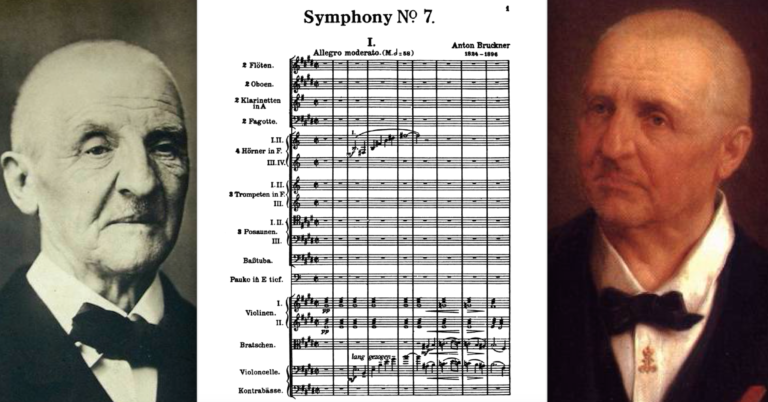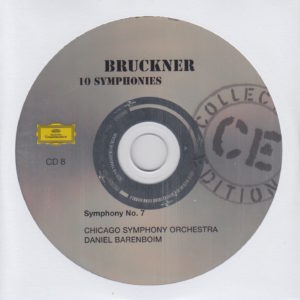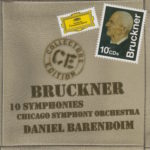This morning, I begin a new cycle of Bruckner conductors (it’s about time!) all of of whom will show me what they’ve got as they interpret Bruckner’s Seventh.
Because this is the start of a new cycle, I thought I’d see a familiar locale in a new way. This is the upper level of a local Panera as seen from the other side of the room. (Light Roast coffee stays the same, though. I couldn’t visit Panera without a few mugs of their Light Roast coffee by my side.)

My forbearing wife is in the foreground.
My laptop is in the background. (As it should be, eh?)
Also, at the start of every new cycle, I change the desktop image on my laptop. Starting today, it looks like this:

This morning’s conductor of Anton Bruckner’s Symphony No. 7 in E Major (WAB 107) is Argentine-born pianist and conductor Daniel Barenboim (1942-), whom I will see in person at Carnegie Hall in January (although the likelihood he’ll see me is nil).
 The orchestra is the Chicago Symphony Orchestra.
The orchestra is the Chicago Symphony Orchestra.
I first heard Maestro Barenboim on Day 1, Symphony No. 1.
Then again on Day 17, Symphony No. 2.
Then again on Day 33, Symphony No. 3.
Then again on Day 49, Symphony No. 4.
Then again on Day 65, Symphony No. 5.
Most recently, on Day 81, Symphony No. 6.
Because this is the start of a new symphony, I like to gather as much background as my forbearing wife will allow me to gather as she sits nearby.
So, I’ll start with the low-hanging fruit: From its entry on Wikipedia:
Anton Bruckner’s Symphony No. 7 in E major (WAB 107) is one of his best-known symphonies. It was written between 1881 and 1883 and was revised in 1885. It is dedicated to Ludwig II of Bavaria. The premiere, given under Arthur Nikisch and the Gewandhaus Orchestra in the opera house at Leipzig on 30 December 1884, brought Bruckner the greatest success he had known in his life. The symphony is sometimes referred to as the “Lyric”, though the appellation is not the composer’s own, and is seldom used.
But first, the objective aspects of this recording.
 Bruckner’s Symphony No. 7 in E Major (WAB 107), composed 1881-1883
Bruckner’s Symphony No. 7 in E Major (WAB 107), composed 1881-1883
Daniel Barenboim conducts
Barenboim used the 1881 version
Chicago Symphony Orchestra plays
The symphony clocks in at 66:36
This was recorded at Chicago, Orchestra Hall in March of 1979
Barenboim was 37 when he conducted it
Bruckner was 59 when he finished composing it
This recording was released on the Deutsche Grammophon (DG) label
Bruckner wrote his symphonies in four parts. The time breakdown of this one (Symphony No. 7 in E Major, “version 1883”), from this particular conductor (Barenboim) and this particular orchestra (Chicago Symphony Orchestra) is as follows:
I. Allegro moderato…………………………………………………………………………20:34
II. Adagio. Sehr feierlich und sehr langsam…………………………………..22:57
III. Scherzo. Sehr schnell………………………………………………………………..10:28
IV. Finale. Bewegt, doch nicht schnell……………………………………………12:37
Total running time: 66:36
Regarding the version (“1883 version”) listed in the liner notes, its entry on Wikipedia tells us:
1883 version
This was the version performed at the work’s premiere. Unfortunately it survives only in one autograph copy which includes later changes by Bruckner and others, so the exact contents of this version are lost. This version is unpublished.
So is it really possible that Daniel Barenboim used the 1883 version? No mention of an editor. (Haas? Nowak? Carrigan?) That bugs me.
From the wonderful little volume, Bruckner Symphonies by Philip Barford, (published in 1978, the asking price of which is now sky high on Amazon):
The key of E major is frequently associated with music of contemplation. Bruckner begins his Seventh Symphony with a warm tremolo third vibrating E-G sharp, from which emerges [the] wonderful theme on the cellos.
It is the composer’s longest theme, and it opens a most beautiful work, which is deservedly loved. The vast, cathedral space within which the work evolves is given primary shape in the solemn, meditative ascent of the E major arpeggio.
The organic unity of this massive work is a miracle of thematic interconnections and the rarest and most stirring sonorities, all drawn out from possibilities of harmonic enhancement hidden in an arpeggiated triad. (from pp. 52, 53)
Of course it is.
I’ll have to take your word for it, Mr. Barford.
Then, from the equally insightful, equally rare volume, The Essence of Bruckner, written by Robert Simpson (also fetching a staggering price on Amazon; as of this morning, over $400 per copy), comes this glowing praise for Bruckner’s Seventh:
That the Seventh is so widely loved is evidence that the impression it makes is direct. Its flowing melody and the intensity of its harmony are finely matched, and the sound of its orchestra gives off a golden gleam. In expression it ranges from exalted serenity to funereal sorrow, and its last two movements are the most purely joyous Bruckner wrote. Nobility speaks from every measure of it. (p. 171)
Okay. I’ve heard from the musicologist and Brucknerians. What say I?
My Rating:
Recording quality: 5
Overall musicianship: 5
CD liner notes: 4 (short essay in three languages)
How does this make me feel: 5
A splendid piece of music!
I’ve listened to it twice through. I didn’t find any of those ear-worm passages I tend to look for, and favor. However, I did hear a grand sweep of music that transported me, especially – oddly enough because I’m not usually a fan of – the Adagio, which I thought was sublime.
A friend once told me that the music of the melodic metal band King’s X is “so beautiful it hurts.”
That’s how I regard the Adagio to Bruckner’s Seventh. There’s so much emotion here that I can feel my heart being tugged out of my chest.
Usually, it’s the Scherzo that rouses me. In fact, I’d say 90% of the time it’s the Scherzo to which I am drawn, and often return to listen.
This time, the Scherzo merely intrigued me – especially its Wagnerian flamboyance in a couple of spots (such as 3:15 in). No, no. This time it was the Adagio that got me. Big time.
This is a very fine recording of an equally fine performance.
I’d have to say “Double Huzzah!” for this one.
